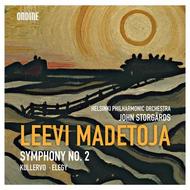
Leevi Madetoja - Symphony No.2, Kullervo, Elegy
£13.25
In stock - available for despatch within 1 working day
Despatch Information
This despatch estimate is based on information from both our own stock and the UK supplier's stock.
If ordering multiple items, we will aim to send everything together so the longest despatch estimate will apply to the complete order.
If you would rather receive certain items more quickly, please place them on a separate order.
If any unexpected delays occur, we will keep you informed of progress via email and not allow other items on the order to be held up.
If you would prefer to receive everything together regardless of any delay, please let us know via email.
Pre-orders will be despatched as close as possible to the release date.
Label: Ondine
Cat No: ODE12122
Format: CD
Number of Discs: 1
Genre: Orchestral
Release Date: 28th January 2013
Contents
Artists
Helsinki Philharmonic OrchestraConductor
John StorgardsWorks
Kullervo, op.15Symphonic Suite, op.4
Artists
Helsinki Philharmonic OrchestraConductor
John StorgardsAbout
To be an orchestral composer in Finland as a contemporary of Sibelius and nevertheless create an independent composer profile was no mean feat, but Leevi Madetoja managed it. Though even he was not completely immune to the influence of his great colleague, he did find a voice for himself where the elegiac nature of the landscape and folk songs of his native province of Ostrobothnia merged with a French elegance.
Madetoja’s three symphonies did not follow the trail blazed by Sibelius, and another mark of his independence as a composer is that his principal works include two operas, Pohjalaisia (The Ostrobothnians, 1924) and Juha (1935), a genre that Sibelius never embraced.
Madetoja emerged as a composer while still a student at the Helsinki Music Institute, when Robert Kajanus conducted his first orchestral work, Elegy (1909) for strings, in January 1910. The work was favourably received and was given four further performances in Helsinki that spring. It is a melodically charming and harmonically nuanced miniature that betrays the influence of Tchaikovsky in its achingly tender tones. Later, Madetoja incorporated Elegia into his four-movement Sinfoninen sarja (Symphonic Suite, 1910), but even so it is better known as a separate number.
Madetoja’s three symphonies form the solid core of his orchestral output. He made his symphonic début in February 1916 with a well-received performance of his First Symphony. He began work on his Second Symphony soon after the first, initially hoping to finish it for the spring season in 1917 but ultimately only completing it late in 1918, just before the première in Helsinki in December. The new symphony was received with high acclaim, and it finally established Madetoja firmly at the forefront of Finnish music; it was generally agreed that it was the most significant piece of music to have been written in Finland since the symphonies of Sibelius.
Error on this page? Let us know here
Need more information on this product? Click here